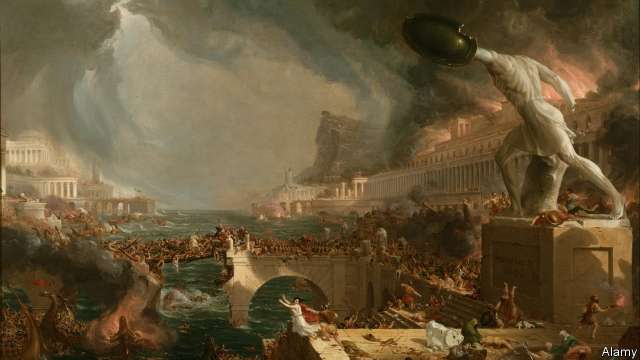Born in Bolton in 1801 at the height of the industrial revolution, Cole entered a polluted and overcrowded world of factories belching smoke into sooty skies. Most artists at the time continued to paint bucolic country scenes, with just a few finding inspiration in this new infernal backdrop to modern life, including J.M.W. Turner and Philippe Jacques de Loutherbourg. Some of their large canvasses bring the viewer into urban streets framed by fiery furnaces that seemed to define the modern city.
But Cole brought these early impressions of a ravaged landscape to the new world, where his family had come in 1818 seeking economic opportunity. Eventually making his way to New York’s Hudson Valley, he helped propel landscape painting to the prestige accorded historical and religious themes, a momentum that eventually led to the founding of the Hudson River School.
The scale and promise of the New World seemed to demand a new monumental art-form. Cole was deeply immersed in the new scientific treatises of the day, reflected in the detail and verisimilitude of the plants, clouds and other natural phenomena of his painted world. But his landscapes almost always strove for the Arcadian, rather than the real. In one of his most famous paintings, “View of the Round-Top in the Catskill Mountains” (1827), he depicts an escarpment overlooking the mountains of the Hudson River valley. Though this area was already a popular tourist destination, he eliminated signs of human presence. Only untouched wilderness stands before the viewer.
He also integrated the era’s literature—another of his famous Catskills landscapes is a scene inspired by James Fenimore Cooper’s “The Last of the Mohicans”. These cross-pollinations reflected Cole’s and other contemporaries’ increasing investigations into the natural and man-made world as symbiotic. In 1836 Cole wrote an essay on the American landscape, the same year that Ralph Waldo Emerson’s seminal essay “Nature” was published.
Cole always sought to enshrine unspoiled nature as an endangered Eden. But his return trip across the Atlantic cemented his ambition to caution Americans about the potential for nature’s demise. After his visit to London and the National Gallery, where he first saw Turners and Constables—some of which are included in the exhibition—and an artist’s grand tour of Italy, he came back with renewed purpose to sound a warning of nature’s destruction by the greed of industry. He felt a special urgency when returning to Jacksonian America in 1832, where manifest destiny and the race west seemed to strip the land at a pace that portended the darkness of industrial Bolton.
While in London and Rome, Cole developed his perhaps most famous and accomplished series, the “Course of Empire”. Along with Turner’s “Hannibal Crossing the Alps”, this series is the highlight of the exhibit. It is also the clearest and most didactic warning of the downfall that Cole was confident that America would experience if the young country did not heed the lessons of the old world. To Cole, the greed that precipitated the American land grab heralded not only environmental ruin, but a cultural and moral one as well.
The five allegorical paintings of “The Course of Empire” (pictured) depict the same imaginary landscape, each representing a different stage of civilisation, in sequence of the times of day. “The Savage State” (top) presents the landscape at its most wild, with hunter-gatherers the only human intrusion into the landscape. The “Arcadian or Pastoral State”, the second, depicts the emergence of music and dance, still an idyll, but with industry and agriculture beginning to take hold. The third painting, “The Consummation of Empire”, shows the city as imposing and imperial, sowing the seeds of the downfall depicted in the next canvas, “Destruction”. In the final scene, the natural landscape is ready to reclaim civilisation’s ruins. It remains unclear whether Cole’s wealthy American patrons recognised this series as a direct warning to them, rather than a flattering, contrasting view of what had happened to old Europe.
Cole was not a conservationist, a movement yet to take root. He seemed resigned to the role of doomsday prophet. Subsequent landscape artists, especially those of the Hudson School, actually rejected most of his proto-environmentalism and instead embraced manifest destiny and American might in their work. The visual world would take many generations to catch up to his urgency about the consequences of industrial progress and what man loses when the land can no longer play its natural role.
Economist
More about: art
















































